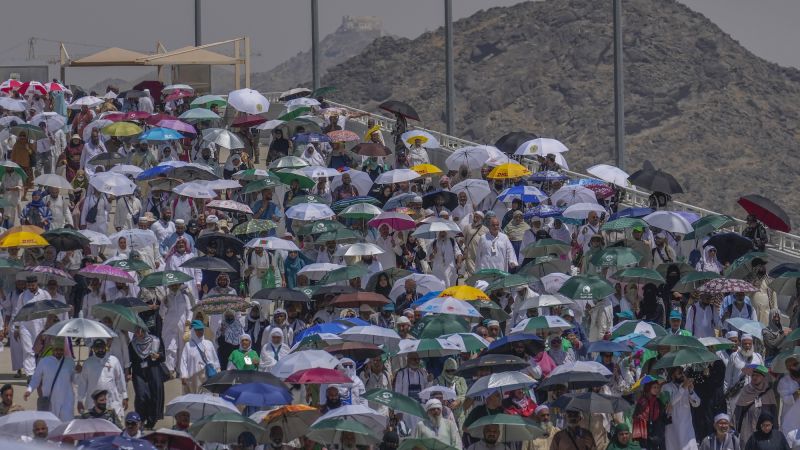
Rafiq Maqbool/AFP
Muslim pilgrims use umbrellas to protect themselves from the sun as they arrive to throw stones at pillars for the symbolic stoning of the devil in Mina, near the holy city of Mecca, on June 18, 2024.
Dubai United Arab Emirates
CNN
—
Hundreds of people died and thousands were treated for heatstroke while performing the annual Hajj pilgrimage to Mecca amid extreme temperatures of 49 degrees Celsius (120 degrees Fahrenheit).
About 165 Indonesians are among the dead, CNN Indonesia reported, citing the Hajj Management Office of the Consulate General of Indonesians in Saudi Arabia. In addition, at least 41 Jordanians, 35 Tunisians and 11 Iranians have died, according to authorities in each country.
The Iranian Red Crescent said on Wednesday that 22 other Jordanians were missing, and 26 Iranians had been taken to hospital, according to Iran’s semi-official Tasnim news agency.
The Iranian Red Crescent said some Iranians died of heatstroke while others were suffering from chronic conditions.
The death toll is likely to rise, as Saudi Arabia and Egypt have not yet published official figures. In addition, governments are only aware of pilgrims who have registered and traveled to Mecca as part of their country’s quota – and more deaths are feared among unregistered pilgrims.
The Saudi government said on Monday that more than 2,700 people had received treatment for heatstroke. Meanwhile, hundreds of people took to social media to post about the loss of their loved ones.
more than 1.8 million people They are participating in this year’s Hajj season, one of the largest religious gatherings in the world, according to the Saudi General Authority for Statistics.
While deaths among pilgrims are not uncommon (there were more than 200 cases last year), this year’s gathering is being held amid particularly high temperatures.
The Hajj season changes every year according to the Islamic calendar, and this year it fell in June, one of the hottest months in the Kingdom.
Saudi Arabia advised pilgrims on Monday not to perform the “stoning of the devil” ritual between certain hours after temperatures reach 49 degrees Celsius (120 degrees Fahrenheit).
Hajj officials asked pilgrims to carry umbrellas and stay hydrated amid the harsh conditions while the Saudi army deployed more than 1,600 personnel with dedicated sunstroke medical units and 30 rapid response teams. Another 5,000 volunteers in the field of health and first aid are participating in this project.
Performing the Hajj is one of the five pillars of Islam, which requires every physically and financially able Muslim to make the journey to the holy city of Mecca at least once in their lifetime.
The Hajj includes many detailed rituals, including wearing a special garment symbolizing human equality and unity before God, a circular procession counterclockwise around The Kaaba is in the shape of a cube Building, symbolically stoning evil.
Source of prestige and income
Hajj is a source of prestige for the King of Saudi Arabia, who holds the title of Custodian of the Two Holy Mosques as guardian of the holiest Islamic sites. But Hajj is also of great importance Source of income for the Saudi economy.
almost King Salman bin Abdulaziz Saudi Arabia took power in 2015 and launched A project worth $21 billion Expansion of the Grand Mosque in Mecca to accommodate an additional 300,000 worshipers. A year later, Deputy Crown Prince Mohammed bin Salman identified Hajj as a key component of the plan Diversifying the Saudi economy By 2030.
Experts say that with oil sales generating nearly $1 billion a day for the kingdom, the economic benefit of the Hajj is marginal in comparison. But its great untapped potential could bring great wealth to the Kingdom in the long term.
The average Hajj revenue was expected to be approx 30 billion dollars annually 100,000 job opportunities were created for Saudis when the Kingdom attracted about 21 million pilgrims annually during the Hajj season, which lasts 10 days in addition to Umrah throughout the year, according to official data reported by Reuters. The government targets 30 million pilgrims by 2030.
This story has been updated with additional information. Edward Sikiris and Handy Al Khashali contributed to the report.

“Travel specialist. Typical social media scholar. Friend of animals everywhere. Freelance zombie ninja. Twitter buff.”





More Stories
Taiwan is preparing to face strong Typhoon Kung-ri
Israel orders residents of Baalbek, eastern Lebanon, to evacuate
Zelensky: North Korean forces are pushing the war with Russia “beyond the borders”